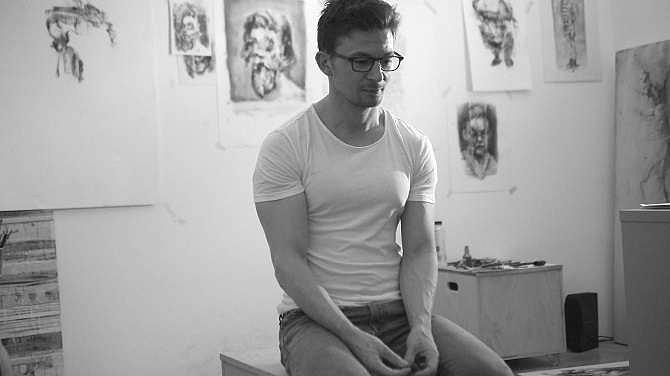Mark Francis Williams draws art and gymnastics together

A British artist living in Bucharest discovers that everything in life, from art, to sports, to music, follows the same patterns.
The building looks massive like an old school. “There’s only renters inside,” says a guy who has just parked his bike and is taking pictures of this downtown Bucharest building. We’re both standing in front of the entrance door. I’m waiting for Mark Williams, a British artist. We agreed for an interview in his studio. The guy next to me is from Enel, a local energy provider. He came to check the electricity readings for those who don’t declare consumption. “They pretend they are never home.” He’s angry at them, and at the building.
Mark Williams shows up- but he is not the pray the electricity guy is after. We pass through a large, shadowy yard and then start climbing the spiral staircase. The stair makes me feel dizzy, but Mark moves easily through the narrow space, with his thin, yet taut body, after years of cycling, running and gymnastics.
The studio is cosy and filled with light. It shelters a bike, a bookcase and many drawings. Actually, not that many, Mark says. He has just shipped several works to a gallery in the UK. Mark has been living in Bucharest for ten years, a great part of his adult life. He almost doesn’t remember how it feels like to live in the UK. He does have his parents there and exhibits almost exclusively in England. But his life is in Bucharest and here is where he transfers his experiences on canvas. “Everything fits your way into your work, but not in a conscious way either.”
Most of his black & white drawings display people. It’s not a random thing, Mark explains. “Our life is about other people. Other people are the main thing that in your head all the time. Of course you notice the environment when you walk down the street, but there is a hierarchy to what you notice. And I’m noticing people.”
Faces are not visible in Mark’s drawings. They are all blurred and ambiguous. He doesn’t go about specific stories and individuals. “If there’s a narrative at all, it’s the narrative …it’s sounds horribly cliché and grandiose…but it’s the narrative of everyone, the narrative of living.”
The backflip
Mark moved to Romania in his late 20s. He didn’t want to work as a freelance illustrator for various clients anymore. “The work became more and more subverted by the client. Eventually I felt like a mini factory. It took away the joy of my own work.” He got a certificate in education and thought he could teach art for a living, while making his own art. That’s how he arrived in Bucharest in 2005, to teach at the British School.
One of the things he knew about Romania was gymnastics. He also knew that he was too old to start training, but he started it anyway. He was drawn by the physical challenge of it. How far can you push something? “That’s like triathlon. I was never interested in team games. For me it’s just like not intense enough. When I cycled, I started with 25 miles, then 40 then 80 then 120. Every time I wanted to cycle more.’
So he started gymnastic, with learning to do the backflip. “I was failing, failing, failing and I thought if I kept trying I would succeed". But his gymnastics teacher told him he needed to stop because he was now teaching himself how to do it badly. “By practicing many times you’re not doing it better, you’re doing it wrong.”
“There’s a difference between determination and obsession,” she explained Mark. “You need to be willing to stop repeating that mistake because you’re going nowhere and change something.”
The line
“In both gymnastics and Kung Fu you have to repeat something to get a form of control and to get rid of the clumsiness,” Mark says.
It’s the same when he teaches kids to draw. Drawing is painful, kids hate it: “I’m no good, I’m no good, I’m no good! I can’t do it.” But same as in gymnastics, you push yourself through the pain and you become better. It’s the same in music. “When you draw a line it’s terrible. It’s like the piano. When someone starts it’s really heavy and clumsy, with time it becomes more fluid. By making many lines, that line becomes a very natural thing to do.”
“A flip for example takes seven parts, but it happens in half a second. Your brain can’t think about seven things in half a second; you know the rules but you can’t implement them immediately. Your body doesn’t understand them. Your brain is panicking. This hasn’t happened before. By repetition you control that panic.”
You succeed when you stop being conscious about it, when you feel it rather than thinking it, Mark explains. “But you can’t just feel it from the beginning. You don’t know the rules. The same with drawing. You can’t just feel it.”
In his work, Mark is trying to find methods by which he’s not that conscious of what he’s making even though he still wants to be in control of it.
“When you walk you don’t think about walking, but you somehow manage to stay balanced.”
The lost art
Last fall, when Mark moved from a rented apartment, and started renovating the place where we met for the interview, an accident happened. He couldn’t bring any of his works to the new place due to the renovation, so he left all the drawings he had made in one year in the former apartment. There were about 40-50 pieces. The new guy who moved in there wanted a bed, so the landlord sent a man to bring the piece of furniture. “He found the work and threw it away. He assumed it must be rubbish. The landlord came. The bed was there and the work was gone.”
The landlord called Mark’s girlfriend at the time, who gave him the news. “In some sense it was good, because it stopped me from repeating myself. It’s like you had a lovely experience somewhere and then you go back and try to do it again. It’s a new experience.”
That’s one of the paradoxes about art and maybe about life too. You want repetition, you want to practice. But at the same time, you want every piece to be new, Mark says.
You might be happy about a drawing, but it’s not like you found the recipe. Whenever you start a new work, you need a new process. “It’s a problem that you’re trying to solve all the time. And if you’re prescriptive, there’s no problem. It’s not interesting.”
Self-doubt is always there, except for very young kids, who are free of it. “The best to teach are 5-7 year old. They don’t judge themselves. They’re immersed in it. They don’t think it’s bad.”
As you become older you just become much more aware. “I constantly ruin the work. One day it seems solid, the next day I just crash it and throw it away.”
A friend of Mark’s likes one of Bruce Lee’s sayings: “Fear not the man who has practiced 10,000 kicks once. Fear him who has practiced one kick 10,000 times.” It’s the same in art, Mark says. “You don’t do ten thousand different kinds of paintings. You do only one kind of painting. You just repeat, repeat, repeat until you refine, refine, refine that idea.”
“It’s the subconscious point again. You practice something until you don’t think about it. It’s almost like a drug in a sense. That’s the nicest feeling, when you’re in the workflow, and you’re not happy nor sad, you’re just in the moment. You’re not judging yourself. You’re making a lot of decisions but really fast.”
Mark Francis Williams
Mark Williams is quite a common name, the British artist says. Google it: there’s a snooker player with this name, a comedian and a professor of clinical psychology. But luckily he is also called Francis. It’s also the name of one of the artists who most influenced him, Francis Bacon. While in school, they had a few books in the art classroom. Bacon’s paintings were in one of them. “It’s beautiful but it’s a bit dark as well, without being like a horror film. Not obviously dark but subtle. For me this is life.”
“We’re not thinking about death every day but it’s there. From the cycle of the seasons to buildings breaking down. I saw that in his work and I was compelled by that. At the same time it’s not a depressing thing. It’s just a reality and you rather love it than fight it.”
I ask him if he ever feels that art distracts him from living. “There’s this phrase, ‘wasted time’. I sometimes feel that, but I also feel that there’s no such thing as wasted time. It’s just time and you do whatever you do with that time. There’s a thousand opportunity costs.
What if I spoke to that girl, what if I bought that t-shirt? They are irrelevant because they didn’t happen.”
By Diana Mesesan, features writer
(Photo by Diana Mesesan)













